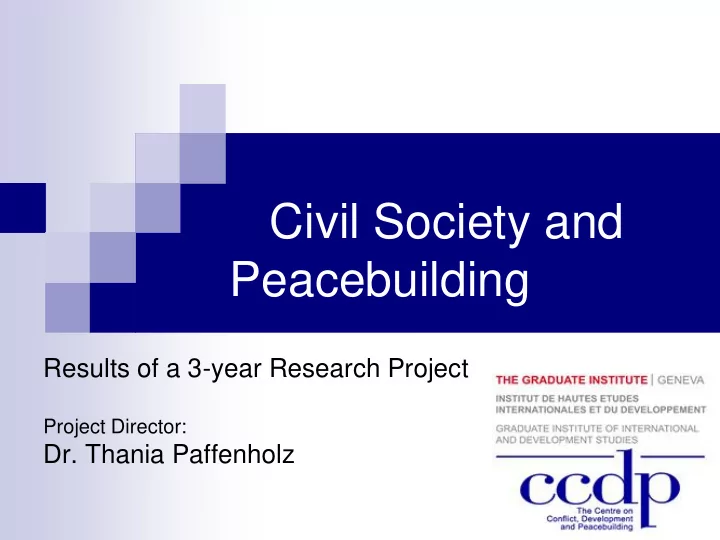

Civil Society and Peacebuilding Results of a 3-year Research Project Project Director: Dr. Thania Paffenholz
Contents: 1. The Project 2. The Results 3. The Implications for Practice 2
1. The project What did we study? What civil society can and did contribute to peacebuilding What is Civil Society? Voluntary organizations independent from the state, business, and private actors like unions, professional associations, sports clubs, traditional actors, religious groups, NGOs, community groups, etc. Who does not belong to CS? Political parties & Media & business (exception: Journalists or private business unions) Focus of Analysis? Local and national civil society groups 3
The project How did we study? Application of the Functional Model to 13 case studies Case studies Guatemala, Afghanistan, Israel/ Palestine, Kurdisch Question (Turkey), Cyprus, Nepal, Sri Lanka, Bosnia&Herzegovina, Northern Ireland, Nigeria, Somalia, DR Congo, Tadzhikistan In-built Policy Relevance Exchange with Practitioners from beginning Policy Paper Workshops + events in Europe, North America, Africa, Asia Team Project Director + 30 Researchers, 25 external experts, support sta 4
5
Functions/Role War Armed Windows of Post Conflict Conflict Opportunity for Peace 1. Protection 2. Monitoring 3. Advocacy 4. In-group Socialization 5. Inter-group Social Cohesion 6. Facilitation 7. Service delivery as entry point for Peacebuilding 6
2. The Results in General Civil Society is a mirror of society Civil Society has important contributions to peacebuilding Contributions are more of supportive nature Many activities focus on dominant conflict lines Context in which CS operates is essential for effectiveness Violence, State, Media, Internal CS composition Donor Trends + Resource allocation influence activities What is relevant is not necessarily done and supported 7
Results in more detail What can CS do especially well? Protection of civil population Monitoring (human rights) Advocacy For relevant peacebuilding topics Agenda setting for peace talks Mass protests/peace movements (ending war or dictatorship) Facilitation at the local level Where is CS currently less effective? Socialization/Peace education Support for social cohesion between adversary groups Focus on dominant lines of conflict Poor effectiveness of most initiatives Service delivery contributes to PB only when systematically used as an entry point for other functions What is context-specific? Facilitation by civil society at the national level 8
3. The Implications for Practice Rethinking of support strategies needed! Discrepancy between peacebuilding relevance and current support Solid analysis and work in scenarios needed Civil society is more than NGOs! Change Agents are needed on professional and voluntary level More focus needed on prevention of different conflicts in society Long-term work with strong socialization institutions needed Support to enabling conditions for civil society of equal importance Support to civil society does not substitute political work! 9
Recommend
More recommend